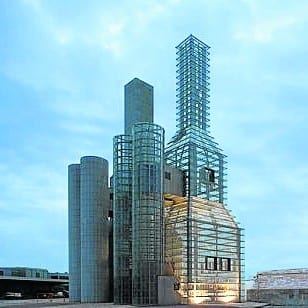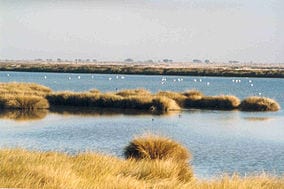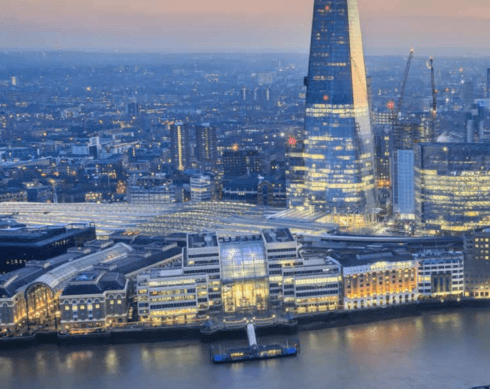IN ancient Thai tradition, to be gifted a sacred white elephant from a monarch was seen as both a blessing and a curse.
On one hand it meant you were in the ruler’s favour, but it was also a curse as the animal was infamously difficult and expensive to maintain, without having much practical use.
Today the term ‘white elephant’ is commonly used to refer to overzealous – often corrupt – spending on projects with costs that far outstrip their worth.
Certainly, a stampede of these such white elephants has carved up Spain over the past two decades.
The economic boom since the late 1990s ushered in a golden age of ambitious expansion that exhausted the nation’s funds, increased borrowing and made the current recession sadly inevitable.
As money flowed into the country’s regional governments, officials invested in flashy projects designed with tourism in mind.
“During the boom, you had a competition between cities to see who could capture the most weekend tourists,” says Llatzer Moix, author of Arquitectura Milagrosa, a book that examines Spain’s obsession with massive urban design projects.
This competitive spirit among Spain’s 17 regions led to a rat race of epic proportions.
First to the finish line was the undeniably delightful Guggenheim art museum in Bilbao, which despite a price tg of €100m, effectively transformed a decaying city into a sprawling metropolis and popular tourist destination.
So successful was it, that dozens of cities around Spain tried to cash in on this so called ‘Guggenheim effect’.
“It seemed like a simple formula,” continues Moix. “Plan a cultural centre, get a star architect to build it, and voila.”
The problem was, other projects cost much more and proved much less successful.
Take, for example, Valencia’s City of Arts and Sciences.
Designed by renowned architect Santiago Calatrava, the colossal structure includes an opera house, IMAX cinema, interactive science exhibit and the largest aquarium in Europe.
While delightful to look at, the project completed in 2005 cost four times its original budget at €1.1 billion.
Put another way, the centre cost more than half the €2 billion Valencia recently requested from Madrid in a bailout plea.
“Instead of worrying about education and healthcare, they wanted the glamour,” reflects Ignacio Blanco, spokesperson of the IU party in Valencia.
And that wasn’t the end of it with Valencia spending on various other unnecessary projects, including the Formula One racing circuit which cost €150 million and nearby Castellon airport, which cost €150 million and has not seen a flight since it opened this year.
Even worse was the city’s so-called ‘Calatrava Towers’ residential project, which has been scrapped, but still earnt architect Santiago Calatrava €15.2 million.
Around Spain exorbitant projects were being undertaken at an alarming rate. Many of them were never even completed.
Take the Oscar Niemeyer International Cultural Centre, located on the estuary of Aviles, in Asturias.
Construction began in 2011 but stopped nine months later after €44 million had already been flushed away.
The Galician City of Culture shared a similar fate. Ambitiously designed by American Peter Eisenman, the six-building project wasted €500 million – five times its estimated cost – before the city ran out of money, with two buildings yet to be built.
“It is a cemetery for money,” complains Pedro Armas, a spokesman for the opposition socialist party in the neighbouring city of La Coruna.
Even more alarming, US architect Wilfried Wang estimates that once finished, the total project will cost €1.2 billion. It is currently on hold.
In addition to cultural projects, Spain has invested big bucks to dramatically expand its transportation system, from building new high-speed rail lines to opening other regional airports.
Between 1999 and 2009, over 5,000 kms of highways were built across the country in the largest road construction project Europe has ever seen.
Some toll roads were introduced that not only failed to make logical sense, but have made almost no money.
Even worse, Spain’s high-speed AVE trains cost almost €6 billion to build yet they only transport about 1% as many passengers a year as the nation’s commuter trains.
One AVE line between Toledo and Cuenca saw just 16 people a day using it and was shut earlier this year.
But whether or not this new infrastructure was needed seemed to be beside the point.
Many regional airports went up close to major city airports.
These included Lleida airport, just two hours from Barcelona, and the Ciudad Real airport, only two hours south of Madrid.
Unsurprisingly, despite costing billions to build neither yields any profit. In fact they hardly have any flights.
The list goes on and on.
What is more, only 11 of Spain’s 48 regional airports actually produce a positive return.
“The problem is that such projects are generally conceived at a time when everything seems bound to succeed – even sometimes badly conceived projects – and there were no doubt some planning problems,” explains Salvador Alemany, chairman of Abertis, an infrastructure company based in Barcelona.
Another key issue is that most Spaniards were completely oblivious to the problem.
Indeed, the lack of transparency here has been a key factor in Spain’s economic crisis, as noted by David Cabo, representative of Civio, a foundation that lobbies for freedom of information.
“It’s terrible because you have many opaque layers of government and each of those control public money,” he says.
But as the recession worsens, these public works projects are becoming exposed for what they really are: fiscal black holes that guzzle money without producing much in return.
The unfortunate result is a massive €140 billion debt.
According to Juan Jose Toribio, an economist with Spain’s IESE business school, the solution to Spain’s white elephant problem may be to target the country’s sacred cows first – namely, its 17 semi-autonomous districts.
“Regional governments enjoy spending and inaugurating public works but they don’t run the political risk or cost of raising taxes. Someone should be held responsible for this and perhaps we should return to a much more centralised system,” he explains.
Whether or not that is the solution, one thing is certain: if Spain hopes to recover from the recession, it needs to address the white elephants in the room.












Oh dear, the same untruths added to the valid points – I wish the English-speaking journalist world would do some fact checking before regurgitating the same-old, same-old…For example there has been no LINE closed between Toledo and Cuenca – they still have AVE connections. Just the direct service, which was introduced as an experiment was discontinued. 6 billion is a lot of money (we assume this is a yearly figure – apparently HS2 will cost the UK 60 billion), but it has resulted to date in various rail export contracts, particularly the Saudi 8 billion contract awarded last year. Good luck to the Spanish rail people who are tendering for contracts in Brazil and Israel this year. Still, they could have spent 20 billion a year instead on housing benefit like the UK?
“the spanish didnt know”. Of course they did. Everyone in Spain could see these mammoth projects springing up everywhere. Who was paying for it? People i knew said the EU !!
We went to Valencia’s Waste when it opened. What a waste of space. Some people drooled over it, some of us thought Whats the point. There is nothing but big business which you have to pay lots to use (imax, handson science center). No budget fo maintanence – the place was falling apart already, and not even finished.
How about making public the finance records? Lets meet the people who pocketed millions over these fiascos.
EnglishDragon,
what crap are you re-gurgitating. How much is it costing Spain in unemployment benefits – 31-33% is the actual unemployment figure.HS2 will cost a lot of money but that is because it should have been constructed decades ago – it will generate real income unlike all the white elephants the Spanish have constructed.
This article is extremely well written, indeed it could have been written at the time the Spanish were looting vast fortunes in gold and silver from Central and South America and what good did it do them – they squandered the lot. They hav’nt changed one iota from that time and as many posters on this forum have said countless times – the Spanish cannot change.
David M – spot on. That’s exactly what the Spanish were saying to me and when I said to Spanish people you are heading for a total collapse their answer was (accompanied by laughter) that’s OK, Brussels will bail us out.
If the Germans say no to more bailouts it’a all over for southern Europe as a whole for decades. Right now many Germans and Dutch are saying ‘close the borders’ to more immigration, because when this collapse happens there will be millions of Spanish/Portugeuse/Italians that will stream northwards.
Article title is misleading. Very few white elephants in story. :(
Stuart – If the article is well-written, then AVE stations like Toledo and Cuenca would no longer be in use. I suggest to you that the statement “One AVE line…was shut earlier this year” is totally misleading – a service was cut, and indeed it was in 2011, not “earlier this year”. Incidentally there is a new direct service between Valencia and Seville that has been introduced this year. Lastly, there are any number of rail contracts overseas that Spanish companies have won (and they are in the running this year for major contracts in places like Brazil and Israel). Don’t believe me? Just read “http://www.railway-technology.com/news/newsohl-wins-2bn-russian-rail-project/” or “http://www.railway-technology.com/news/news95859.html” or “http://www.railwayinsider.eu/wp/archives/25553” Do you really think Spain would have been in a position to bid for (still less win) those types of contracts had they not invested in their modern rail systems?
While there is a some truth, the rest of the article is a lot of bullsh*t, most of the so call white elephants are more than necessary infrastructure, now you get highways and motorway connecting the whole country, been Spain only second to Germany in kms of Highways and only second to Japan in High speed Train lines.
As EnglishDragon suggest this provided a tecnology base that wasnt there before resulting in contracts all over the world, for instance now OHL and FCC are fighting to get the underground contract for NewYork for 22billions…or all the highways build by spanish companies in Australia or middleeast.
Same happens with the Defence Industry which has provided great result, exporting carriers and destroyers to Royal Australian Navy for example.
Our main problem is Socialism in its worst.
Getting employees to tell you I cant be ask to work, I rather go to paro, coz I know the government is going to provide for me 1200€ monthly, and that to fire anyone it use to be no less than 12000euros with the previous law…That brought us cultura del vago!!!
People in Andalucia is confortable been unemployed, it doesnt look as something bad or temporary. Change that culture and problem is solved. Labour Flexibility, cheap firing, 3 month max uneployment benefits, that would get everyone to find a job asap and stop the slacking
Admiral Lezo,
what a handle – relative of yours was he?
All that Spain has are autoroutes and RNs it has no tertiary road system at all – that’s why La Veulta has to use RNs and in places autoroutes.
I suggest you visit France which has the most complete road system of anywhere in Europe.
All the fault of Socialism – spoken like a true Falangista.